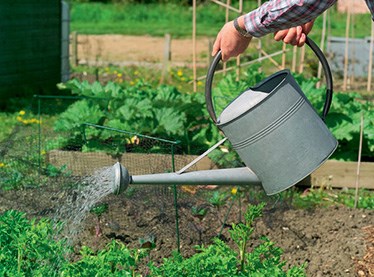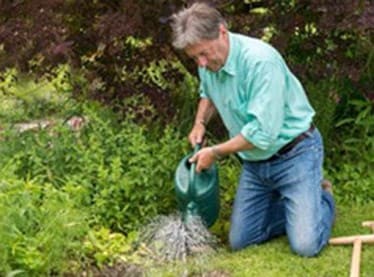Refresh your lawn
Lawns can make all the difference to the appearance of your garden. A nice cut and neat trim is all that it takes. For most family lawns, make the first cut with the blades set high when the grass reaches up to your ankles. With subsequent cuts, reduce the cutting height to leave just a few centimeters of grass on the lawn after each cut. If you want to achieve a finer finish, you will need to buy a cylinder mower, so that you can reduce the cutting height accurately to around just15-20mm.
If your lawn is looking a bit the worse for wear after the winter, you may need to give it the full renovation treatment. A few dandelions can be hooked out with an old kitchen knife or a special weeding tool. Or, if you don’t mind using chemicals, tackle them with a special lawn spot weeder.
For larger weed infestations, the job will be a whole lot easier if you apply a lawn weedkiller to the entire sward. You can the lawn, too, by choosing a combined weed-and-feed treatment and where moss is also a problem, the triple-action lawn weed, feed and mosskiller will do the job in one fell-swoop.
On small lawns, it is easy to scatter granular products by hand, but for larger areas, use a fertiliser spreader for quicker and more accurate results.
If you want to achieve a finer finish, you will need to buy a cylinder mower,
so that you can reduce the cutting height accurately to around just 15-20mm
Secret supports
There’s nothing more frustrating than to have your favourite border plants collapse in a heap just as they are coming into flower. Flopping perennials can also make it a lot more difficult to mow the lawn and negotiate garden paths. You can prevent flopping flowers by inserting supports now, just as the plants begin to grow.
Not only is the job a lot easier if you do it now, but you are less likely to damage emerging growth which will soon shoot up and hide the supports. For clump-forming perennials, you can use twiggy prunings pushed into the ground or buy special linking stakes that are very easy to put together.
Rocketing perennials, such as delphiniums, that produce large flowers on single stems, are best supported individually with a bamboo cane and split ring or piece of soft-tie, or a special single stem support device.
Trend-setting annuals
Hardy annuals might conjure-up images of old-fashioned cottage gardens filled with calendula, candytuft, centaurea, cosmos, eschscholzia, nigella, nicotiana, scabiosa and poppy, but this largely neglected group also contain trendy flowers, such as Ammi majus and Orlaya grandiflora that are all the rage in top garden-designer circles.
If the weather and soil conditions allow, hardy annuals can be sown direct outside from the middle of April. Wait until next month if you live in the north or your garden is prone to late frosts. Alternatively, sow them in pots or trays in a coldframe or under cloches in a sheltered corner of the garden.
Before sowing them direct outdoors, you will need to prepare a seedbed by digging the ground thoroughly and raking it level. There is no need to add fertiliser since most hardy annuals are well-adapted to impoverished conditions. Hardy annuals flower where they are sown, but sowing in rows will produce a rather unnatural, ordered appearance.
One option is to scatter the seeds willy-nilly by broadcast sowing, but that will make weeding the seedlings very tricky. Instead, sow them in short, straight rows within fish-scale-shaped zones marked out on the surface of the soil. But make the parallel drills in each fish-scale zone at a different angle to those in adjacent zones.
That way, any weed seedlings are easy to spot amongst the short rows of flower seedlings, yet the overall display will still look carefree and informal – just as nature intended.
Feed permanent plants
If you haven’t done so already, it is still worth applying a general fertiliser, such as the organic pelleted poultry manure and blood, fish and bone or else growmore around permanent plants including roses, shrubs, trees and climbers following the manufacturer’s instructions.
Also feed fruit trees, bushes and cane fruit.
Easy-care baskets
If you are planning on having basket displays this summer, this month is an ideal time to get all the materials together. If you have somewhere frost free you can keep the basket, you can plant it now, too. That way, the plants will have settled in and started to motor by the time they are placed outside in their flowering position.
To keep maintenance to a minimum, choose a large basket that will hold the most Top tip of the month, so you don’t have to water it as frequently. You can also get self-watering baskets, with built-in reservoirs that reduce watering time further. Even standard wire-mesh baskets lined with sphagnum moss or a ready-made liner can be made easier to water by placing an old saucer or piece of polythene to act as a reservoir inside the basket, before adding the Top tip of the month and planting-up. Incorporating water-retaining gel into the Top tip of the month mix before planting will help, too.
Stay cool
Ventilate and shade your greenhouse as required to prevent sun scorch and avoid damping off problems with seedlings.
Save time opening and shutting windows by installing an automatic vent opener. Put up shading material to protect seedlings and young plants to start with, adding more shading as necessary later.
No more weeds
By keeping on top of weeding this month and next, you can enjoy a largely weed-free garden for the rest of the year. Use a hoe to scuff-off annual weeds between vegetable crops and established plants in the border, but deal with perennial weeds individually using a weed fork to be sure of removing the roots.
If you don’t mind using chemicals, dab a spot weeder (based on glyphosate) onto the leaves of weeds – the chemical will be transported through the whole weed killing the roots as well. For more widespread weed infestations, it would be quicker to use a hand-sprayer to apply the chemical, but take care to cover nearby ornamental plants with polythene, so that they are not harmed.
Monthly checklist
- Plant evergreens trees and shrubs
- Tie in climbers
- Divide perennials
- Protect against slugs and snails
- Add new pond plants
- Deadhead daffodils
- Top-up mulches
- Prune spring-flowering shrubs















